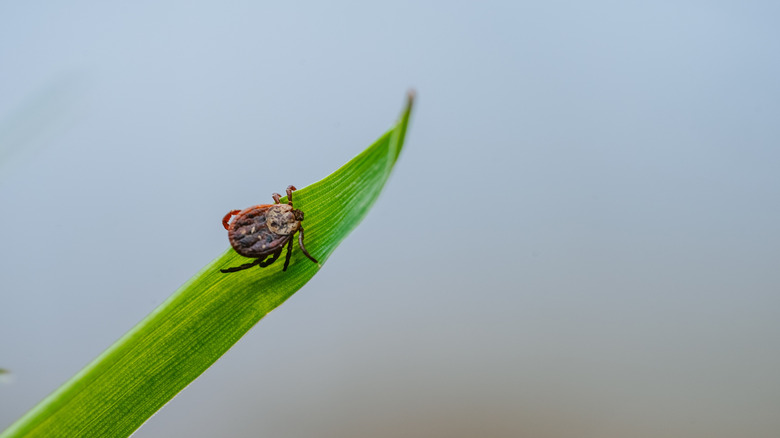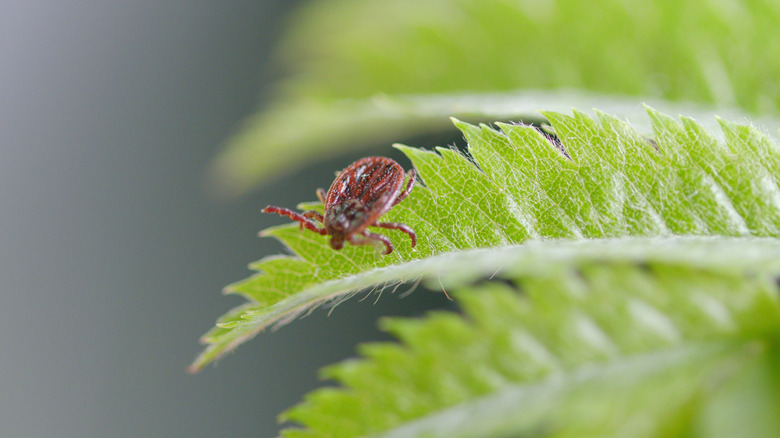The Tick-Attracting Plant You'll Probably Want To Avoid Growing In Your Yard
Of all of the nuisance pests out there, ticks are one of the worst. These biting arachnid invaders can quickly ruin your day. While you may think that you have to go deep into wooded areas to find them, it's possible you might be attracting them without knowing it thanks to a common plant in your yard. The unlikely culprits? Ferns. While ferns are considered low-maintenance and popularly used for ground cover, they can have a negative side, as they offer a welcoming environment for ticks to make their home.
Advice on keeping ticks out of your yard can be confusing. Deer are well-known hosts of the pests, and some experts advise using ferns in your yard because deer typically avoid them. That move, in theory, helps cut down on tick activity. Yet if you plant ferns near your home, you might as well create a five-star resort for ticks. Ticks may also arrive in the yard by hitching a ride on rodents such as mice or squirrels — no deer taxi required. No matter what draws them into your yard, remember that ticks can be a hazard to the health of you and your pets. As symptoms from tick-borne diseases like Lyme disease can range from hidden to severe, it's important you focus on not creating an environment that may attract ticks to your outdoor space. Being proactive about plants that don't make a good habitat for ticks is a good way to prevent these pests from spending time in your yard. Here's why your ferns could be attracting ticks, plus alternatives to consider.
Why ferns in your yard can attract ticks
Multiple tick species within the United States prefer shady, low-light conditions and plenty of shelter when they're outdoors. They will often seek out moist, vegetative areas, which makes ferns ideal habitats. The low-lying, spreading nature of ferns provides a dense ground cover and the humid environment they prefer. Ticks don't fly — instead, they ambush you from low on the ground or nestled among vegetation. The fern's thick foliage gives them good cover, and when a potential host (i.e, you and your pet) stops by, that's their time to shine. They make their move, easily hitching a ride on a limb as well as latching onto your clothing, where they may bite. And unless you've gone through all of your plants carefully for them, you likely don't know whether your yard is home to ticks or not.
Avoiding ferns in your yard can help with avoiding ticks, but what do you do if ferns are already part of your landscaping? Don't worry — you don't have to rip them out of the ground. One way to prepare for ticks in your yard is to regularly trim your ferns, opening up space between the ground and the bottom of the plant. By doing so, you reduce their shade cover and minimize the shaded places where these critters like to hide. This method is also a good alternative to spraying pesticides to kill ticks. It's hard to target these bugs directly, and you may accidentally harm pollinators in the process.
Choosing alternatives to ferns for planting
When creating an environment hostile to ticks, you can add plants that the arachnids often avoid. There's an array of beautiful plants that can keep ticks at bay. Using fragrant options, such as species of rosemary or lavender, are both ideal to enjoy delightful scents and gorgeous blooms while repelling ticks. You can also plant annuals such as marigolds and sage, as well as perennials like daffodils. Lemongrass (Cymbopogon citratus) is well-known for repelling mosquitos, but also packs a pungent smell that ticks hate. If you still want the ground cover a fern offers, creeping thyme (Thymus praecox) offers the same effect while also releasing a scent that ticks find detestable.
Avoid adding any species that are recognized as invasive in your area or they may compete with the surrounding plants. Be sure you keep the grass regularly trimmed to a height of 2 inches to mitigate chances of tick habitation. If you live on the boundary of a wooded area, create a dry, inhospitable barrier by lining the perimeter with wood chips. These steps are especially important during the so-called "tick season," the stretch of months marked with the most tick activity. This is typically April through September, but the specifics vary by region.


